FILIBUSTER in Robert's Rules?
LITTLE BEN SAYS: “Handle division this way.”
Robert McConnell Productions received an inquiry on how to handle a meeting where members where going to filibuster a proposed bylaw amendment. Of course this Senate procedure where it allows the minority to dominate a discussion and even prevent a vote, has no place or authority in organizational meetings. So what can you do if a minority tries to high jack a meeting this way?
First, remember every member has a right to participate and to influence members through discussion to either adopt a motion or defeat it. Every organization knows the “hot button issues.” When these arise, then certain procedures need to be put in place so that order, respect and harmony can prevail even though it is a hot button issue.
The agenda should have a notation at the bottom how to rise, address the chair and speak. That debate is to be kept to the issue not to personalities. That debate will be alternated between those who are for and those who are against.
Someone should prose a motion to limit debate to about three minute per speaker. This will stop the rambling and allow enough time for many speakers. If it looks like someone will try to stop the discussion by making the motion the previous question early in the debate, a motion can be made that so many speakers on each side will be allowed to present information before the motion previous question can be made. For example, “I move that 12 members on each side be allowed to speak before the motion previous question can be made.” This takes a second and a two-thirds vote.
The important key to keeping an organization unified where members do not leave after something very controversial is to make sure that the minority feels they had the right to speak and for their ideas to be heard. This does not mean that some will not go away with hurt feelings, but it does mean that they will leave knowing that they were heard and the other members did not accept their reasons.
Little Ben likes this quote from General Henry Roberts: Where there is a radical difference of opinion in an organization, one side must yield. The great lesson for democracies to learn is for the majority to give to the minority a full, free opportunity to present their side of the case, and then for the minority, having failed to win a majority to their view, gracefully to submit and to recognize the action as that of the entire organization, and cheerfully to assist in carrying it out, until they can secure its repeal.”

